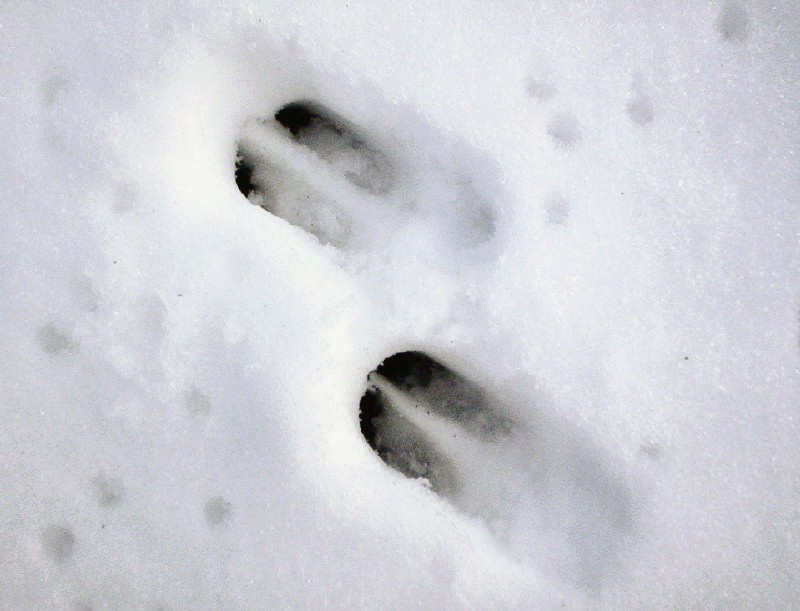If you live anywhere it snows, you should rejoice each time it does. A fresh snowfall transforms the woods into a blank page and, as the day progresses, wildlife writes a story. And, if you read it correctly, you’ll benefit in many ways.
Snow allows hunters to see where deer have been and where they’re going. It also helps hunters preserve meat and blend into their environment. Along with its many benefits, snow brings a set of challenges, too, but these are easy to overcome. Let’s go over the benefits of hunting after a fresh snowfall.

Deer tracks are very obvious in the snow. Photo Credit: HuntingNY
Anything that isn’t white is easy to spot on a snowy canvas. When hunting, you’ll have an easier time identifying the following:
Deer: Because white-tailed deer are brown, the contrast against the snow makes deer easy to spot when they move. But stay alert. Snow dampens sound, so hunters must continually scan their environment to locate deer.
Tracks: A fresh layer of snow compromises an animal’s whereabouts, because anything that moves leaves a mark. This helps hunters determine if deer are in the area. If they are, analyze their tracks to learn the deer’s size, which direction it was headed, if it was walking or running, and if it was alone. Click here to discover how to decipher animal tracks and sign.
Blood trails: Arrowing a deer in the snow makes tracking straightforward. If you made a clean, pass-through shot, the deer should bleed profusely, and red blood drops will be easy to spot. If you made a poor shot or your arrow didn’t penetrate through the deer, the blood trail will be light. Regardless, you should still be able to follow the wounded animal’s tracks. You must still carefully trail your deer because it may cross paths with other deer, which can complicate the process.
Tree limbs: In winter, trees are bare. Without foliage, small limbs and branches become hard to see against the ground. Snow, however, fixes this problem. Aside from Birch trees, most tree bark is brown. Much like a deer’s brown coat, brown branches contrast well against the snow. They’ll look like black lines on a white canvas in your shooting lanes.
Snow forms at or below freezing, which is 32 degrees Fahrenheit. All hunters strive to make quick, humane harvests, but things don’t always go as planned. If you arrow a deer in a non-vital area, you must give it time to expire. Many hunters wait overnight to begin searching. This strategy will ruin meat if it’s hot, but snow and cold temperatures act as a freezer and preserve venison naturally. As long as scavengers don’t find your kill, the meat will be safe to eat once it’s thawed.

You can blend in easily to the trees and snow with snow camouflage. Photo Credit: Whitetail Habitat Solutions
If you love hunting from the ground, wear snow camouflage after a fresh snowfall. If you use snow camo, you’ll look like a snowdrift and disappear into the environment. Treestand hunters can wear snow camo to blend in if it’s snowing or has recently snowed enough to blanket the branches.
No deer cart or four-wheeler? No problem. Snow acts like a lubricant between the ground and a horizontal deer. Therefore, as hunters pull the carcass, it will easily glide along. That said, hunters might struggle on two feet if the snow is deep. They’ll sink in, slowing their progress. Consider using snowshoes, which distribute your weight over a large surface area and help you stay on top of the snow rather than sinking into it.

Thick snow can make it hard to judge what’s underneath the snow that you might step on. Photo Credit: Outdoor Canada
Of course, snow can make for a tricky hunt as well, affecting everything from the drive to camp to staying warm. Here are a few problems to watch.
Snow makes treestands slick. If you’re not hunting from a ground blind, you must be extremely careful climbing a tree and transitioning to your treestand platform. Snow can make surfaces slick and difficult to hold. Wipe the snow from your ladder or tree pegs, and clear the snow from your boot treads to ensure you have grip and traction when climbing.
Snow covers everything. Snow hides everything it touches, including logs, holes, and frozen ponds or watering holes. Disguised by snow, these hidden items become an obstacle course, which makes walking a challenge. Consider using a trekking pole or snowshoes to navigate the terrain with confidence.
Hunting in the snow is a lot of fun, but it can also be frigid. Learn how to stay warm in the Bowhunting 360 article, “Bowhunters: You Can Stay Warm in Cold Weather.”